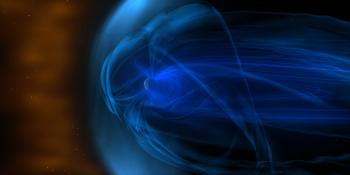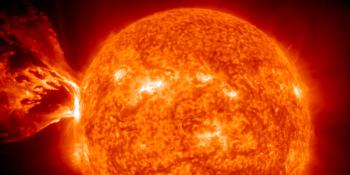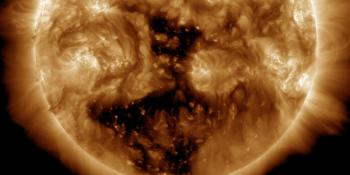Visualizzazione archivio di martedì, 15 aprile AM
Daily bulletin on solar and geomagnetic activity from the SIDC
Emesso: 2025 Apr 15 1231 UTC
SIDC Forecast
Brillamenti solari
M-class flares expected (probability >=50%)
Geomagnetism
Moderate (ISES: Major) magstorm expected (A>=50 or K=6)
Protoni solari
Warning condition (activity levels expected to increase, but no numeric forecast given)
| 10cm flux | Ap | |
|---|---|---|
| 15 Apr 2025 | 153 | 011 |
| 16 Apr 2025 | 154 | 043 |
| 17 Apr 2025 | 156 | 013 |
Solar Active Regions and flaring
Solar flaring activity over the last 24 hours has been moderate, with one M-class flare and multiple C-class flares. The strongest flare was an M1.5 flare (SIDC Flare 4136) from beyond the east limb, peaking at 10:20 UTC on April 15. There are currently three numbered active regions on the solar disk. The most complex one is SIDC Sunspot Group 450 (NOAA Active Region 4060, magnetic type beta-gamma). SIDC Sunspot Groups 469 and 470 (NOAA Active Regions 4055 and 4058) have rotated behind the west limb. A new, currently unnumbered active region (SIDC Sunspot Group 473, magnetic type beta) has rotated on disk from the east limb. The solar flaring activity is expected to be at moderate levels over the next 24 hours, with C-class flares expected, M-class flares probable, and X-class flares unlikely.
Espulsioni di massa coronale
Two narrow Coronal Mass Ejections (CMEs) were observed in LASCO/C2 coronagraph imagery, lifting off the south limb. The first was observed around 14:30 UTC on April 14 and the second around 23:45 UTC on April 14. They are not expected to impact Earth. No other Earth- directed CMEs were observed in the available coronagraph imagery.
Fori coronali
An equatorial, negative polarity coronal hole (SIDC Coronal Hole 105) has emerged near the central meridian. An associated high-speed stream is expected to arrive at Earth starting from the UTC evening on April 17.
Vento solare
Over the past 24 hours, the solar wind parameters (ACE and DSCOVR) reflected slow solar wind conditions. Speed values were between 400 km/s and 440 km/s. The interplanetary magnetic field values were between 5 nT and 7 nT. The Bz component was mostly negative, with values varying between -6 nT and 5 nT. The interplanetary magnetic field angle was predominantly in the negative sector. Enhanced solar wind conditions are expected over the next 24 hours, due to the expected arrival of the interplanetary Coronal Mass Ejections (ICMEs) associated with the CME that lifted off around 23:00 UTC on April 12 and the partial halo CME that lifted off around 08:30 UTC on April 13. A mild high-speed stream from SIDC Coronal Hole 101 may also arrive at Earth over the next 24 hours, but may be indistinguishable from the ICMEs.
Geomagnetism
Geomagnetic conditions globally were mostly at quiet to unsettled levels (NOAA Kp 2 to 3), reaching active levels (NOAA Kp 4) between 21:00 UTC on April 14 and 00:00 UTC on April 15. Geomagnetic conditions locally reached minor storm levels (K BEL 5) between 22:00 UTC on April 14 and 01:00 UTC on April 15. Moderate storm conditions (NOAA Kp 6, K BEL 6), with possible major storm intervals (NOAA Kp 7, K BEL 7), are expected globally and locally over the next 24 hours, due to the expected arrival of the Interplanetary Coronal Mass Ejections (ICMEs) associated with the CME that lifted off around 23:00 UTC on April 12 and the partial halo CME that lifted off around 08:30 UTC on April 13.
Proton flux levels
The greater than 10 MeV proton flux was below the threshold level over the past 24 hours. It is expected to remain below the threshold level over the next 24 hours.
Electron fluxes at geostationary orbit
The greater than 2 MeV electron flux measured by GOES 18 was above the threshold level between 16:00 UTC on April 14 and 01:40 UTC on April 15. The greater than 2 MeV electron flux measured by GOES 19 was above the threshold level between 11:50 UTC and 17:25 UTC on April 14. The greater than 2 MeV electron flux is expected to remain mostly below the threshold over the next 24 hours. The 24-hour electron fluence is presently at normal levels and is expected to remain so over the next 24 hours.
Today's estimated international sunspot number (ISN): 071, based on 10 stations.Solar indices for 14 Apr 2025
| Wolf number Catania | /// |
| 10cm solar flux | 152 |
| AK Chambon La Forêt | 028 |
| AK Wingst | 025 |
| Estimated Ap | 020 |
| Estimated international sunspot number | 080 - Based on 19 stations |
Noticeable events summary
| Day | Begin | Max | Fine | Loc | Strength | OP | 10cm | Catania/NOAA | Radio burst types | |
|---|---|---|---|---|---|---|---|---|---|---|
| Nessuna | ||||||||||
Provided by the Solar Influences Data analysis Center© - SIDC - Processed by SpaceWeatherLive
Tutti gli orari in UTC
<< Vai alla pagina della panoramica giornaliera
Ultime notizie
Ultimi messaggi dal forum
Supporta SpaceWeatherLive.com!
Molte persone vengono su SpaceWeatherLive per seguire l'attività del Sole o sapere se ci sia la possibilità di vedere l'aurora, ma a maggior traffico corrispondono costi maggiori. Considerate una donazione se vi piace SpaceWeatherLive così che possiamo mantenere online il sito web!

Notizie sul meteo spaziale
| Ultimo brillamento X | 2025/03/28 | X1.1 |
| Ultimo brillamento M | 2025/04/15 | M1.2 |
| Ultima tempesta geomagnetica | 2025/04/15 | Kp6+ (G2) |
| Giorni senza macchie | |
|---|---|
| Ultimo giorno senza macchie | 2022/06/08 |
| Media mensile Numero di Macchie Solari | |
|---|---|
| marzo 2025 | 134.2 -20.4 |
| aprile 2025 | 124.1 -10.1 |
| Ultimi 30 giorni | 124.7 -16.6 |


